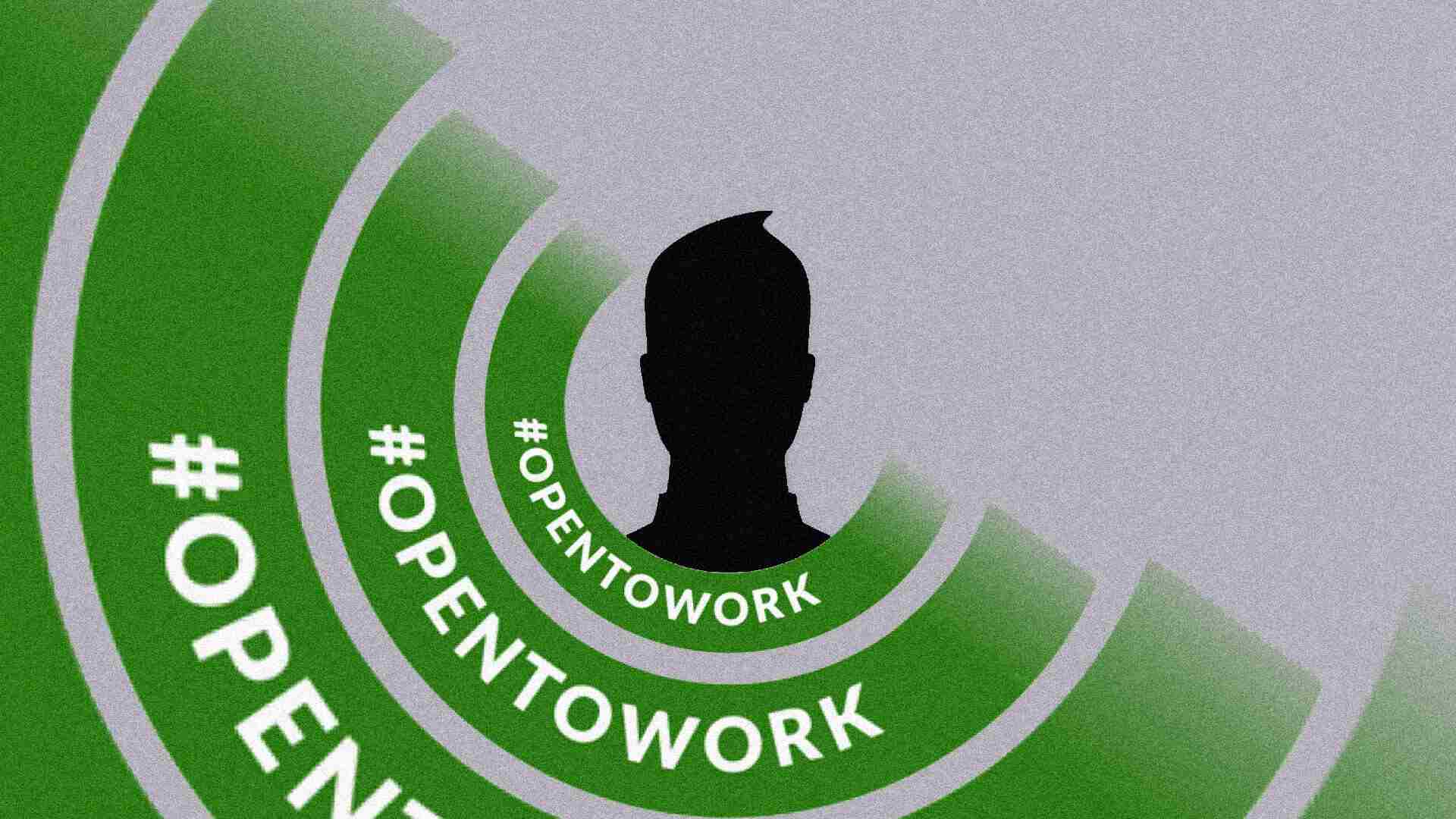- | 8:00 am
Before you use the ‘Open to Work’ badge on LinkedIn, read this
The ‘Open to Work’ badge on LinkedIn gets a bad rap, say some experts. Here’s how you should be using it in your job search.

After social media manager Jensen Rubinstein was let go from her job in January, she put the green “Open to Work” banner up under her LinkedIn profile photo. Along with a short post about the reason for her job loss, the banner almost immediately caught the eye of a director at a small publication looking to fill a contract position—a role she landed and still serves in today.
It also snagged her a first-round interview at another company she was pleasantly surprised to be considered for. “It wouldn’t have been on my radar, and it’s not really in an industry that I would’ve been super interested in working in, but they contacted me,” says Rubenstein (who, full disclosure, was a coworker at a previous job).
LinkedIn introduced the #OpentoWork badge in 2020 in response to a wave of pandemic-related layoffs and hiring freezes—the idea being that job seekers could more obviously signal to those who were still recruiting that they were ready and available for work. And since its inception, there’s been intense debate about the efficacy of the photo frame, with some people calling it “desperate” and warning it will hurt your chances of getting a callback; or potentially worse, make you more susceptible to employment scams.
“There is the old adage that it is harder to find employment when unemployed,” says Olivia Johnson, a career coach and business consultant. “So, if you are a believer of this, you are flagging your unemployment.”
That said, Johnson and other career experts argue that the benefits of using the banner outweigh the risks. Here’s how they suggest leveraging it to get the attention of hiring managers:
WHO IT’S FOR
If you’re currently employed and trying to keep your job search under wraps, this badge isn’t for you. As an alternative, you can select the “Recruiters only” option, which, rather than broadcasting to the whole world your desire to move on, only shows people who have access to LinkedIn Recruiter that you’re open to opportunities. Note, however, that LinkedIn can’t guarantee that the badge won’t still be viewed by a recruiter at your company.
But, other than that instance, the green banner is a great option for anyone entering the job market for the first time, or returning to the workforce as a result of a layoff, career pause, or career switch. “There [are] just so many people on the market and looking for work that showing recruiters and hiring managers, ‘Yes, I’m open,’ is generally a very good thing to do,” says Mike Peditto, director of talent at job search platform Teal.
WHY IT WORKS
You have little to lose in putting the banner up. “If it’s not working and if you feel like it’s hurting you, take it down and see if there’s a difference,” Peditto says. “It is very unlikely that the reason you’re not finding a job is if you are or not using the banner.”
Mark Toscano, executive healthcare recruiter at recruiting firm LeaderStat, says that for recruiters, it can provide a boost to an otherwise lengthy or tiresome hiring process. They’re busy people working under strict, often accelerated, timelines, and someone who’s looking for a job is easier to woo than someone who’s not actively job searching. As he puts it, a candidate with the banner is “much more likely to respond to a message on LinkedIn or a text or a phone call.”
He says, “They’re just as qualified as everybody else, but I’m going to start with them because they’re more likely to get back to me, and my client wants me to find somebody quick.”
Data backs up this theory: According to a 2023 survey conducted by Teal, 91% of hiring professionals don’t view the “Open to Work” banner as a deterrent, and 72% of respondents said they have hired candidates who used the banner.
For jobs you’re actively applying to and interviewing for, the banner can also be of service. Irina Pichura, a job search strategist and former recruiter, notes that with more opportunities on your plate, you’re better able to negotiate a higher salary or title when you reach the offer stage.
WHEN IT CAN HURT YOUR JOB SEARCH
Some hiring managers, though, might be turned off by the badge for one reason or another, but many experts suggest that those aren’t the kinds of companies you’d want to work for, anyway—and for every recruiter who turns their nose up at it, there are hundreds of others who don’t give it a second thought.
However, the banner can be detrimental if it’s the only thing you rely on. “If you’re not sharing content or making noise on LinkedIn, you’re going to have very little traffic toward your profile,” says Sean Hodges, a marketing account director based in London who uses LinkedIn Recruiter and the “Hiring” badge to connect with potential hires. (The “Hiring” banner is for recruiters, and basically functions as the inverse of the “Open To Work” badge.) “[The] best examples I’ve seen are embracing the green banner, but then going about explaining your situation” in a post or your “About” section. Without anything else to shed light on your qualifications and availability, a recruiter might brush you off as a bad fit or even a fake profile.
HOW TO TURN THAT BADGE INTO A JOB
The banner is just one of many tools in your LinkedIn tool belt. To get ahead of the competition—and turn those recruiter views into a phone call or interview—start with a rock-solid profile. This might include a strong headline, which is one of the first things Peditto looks at. That makes it clear what you do and/or what your skills are. Another aspect to spruce up, he says, is your “About” section. (Read more about how to refresh your profile here.)
Brandon Dock, a division lead of executive recruiting at TGC Search, says a recommendation from a former coworker or manager can help ease concerns around an unexplained career break. Additionally, he looks for tenure, loyalty, and career progression. “Instead of just saying you’re with company X for 10 years, showing that you are with company X for 10 years, but you were hired as an accountant, then promoted to senior accountant in two years, then controller in three years, and then director of finance,” he says.
“That means that you’ve been working at your company for a while, you’re doing well, and they’re promoting you for one reason or another,” he says. “You must be doing something right.”
Finally, experts agree it’s important to stay active on LinkedIn by regularly sharing articles, responding to other people’s posts, and following trends or influencers. “The more you post, the more you engage, the more your name and your profile pops up on people’s feeds. And that’s just sort of a way to get yourself seen,” Peditto says.
LinkedIn is still one of the most widely used recruiting platforms out there, and job seekers will only gain from using every hack it provides—even one as obvious and simple as the “Open to Work” banner. “Most of my clients are finding work on LinkedIn,” Pichura says. “It’s not even a negotiable at this point.”







































